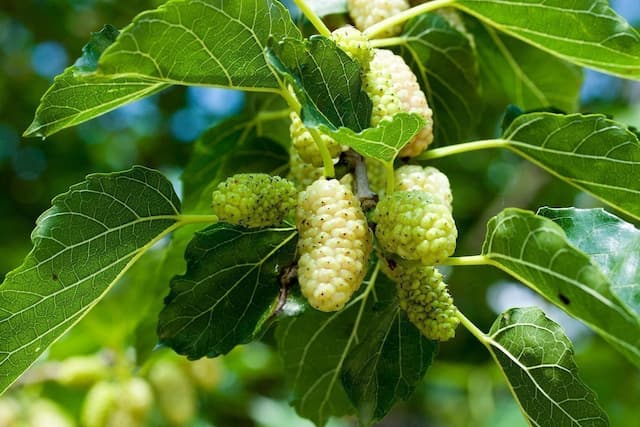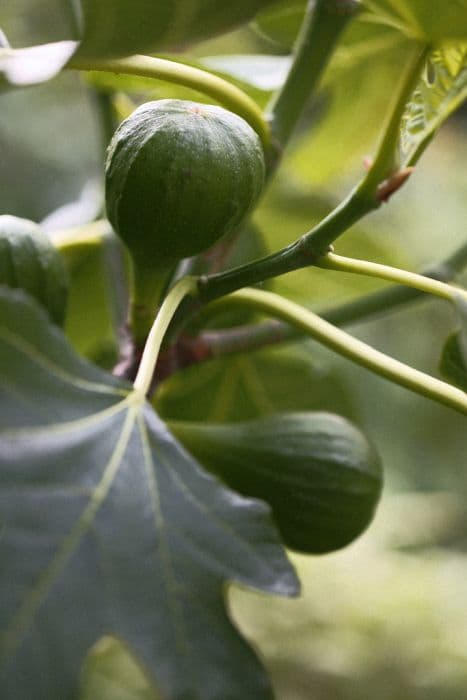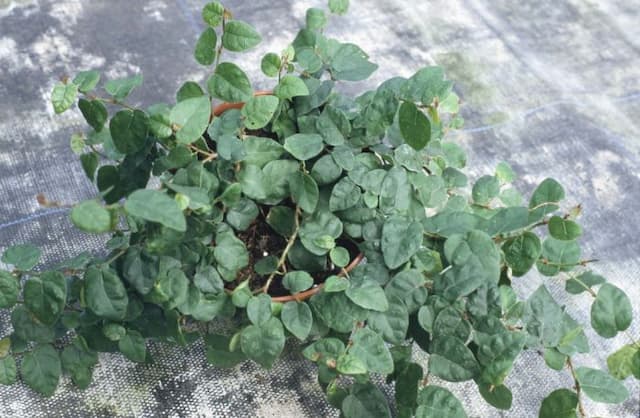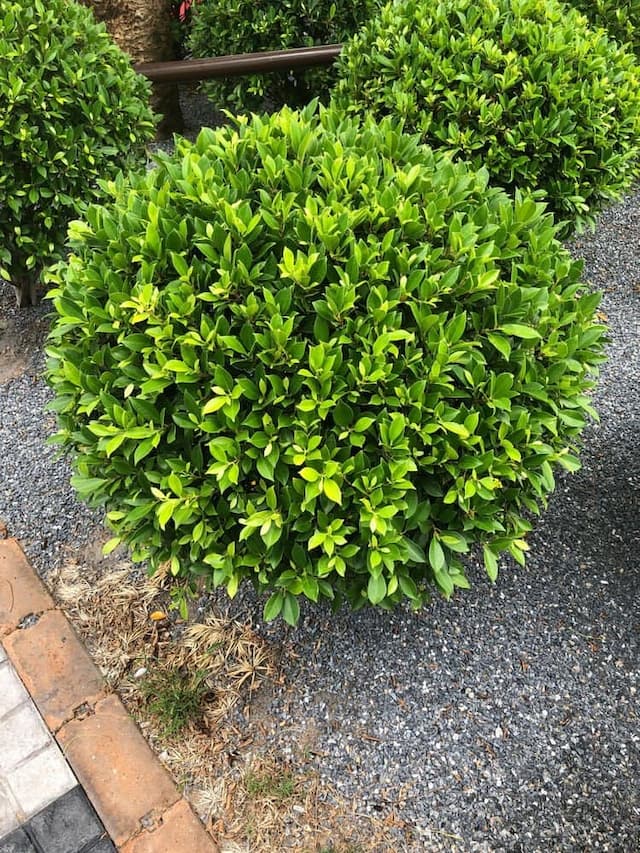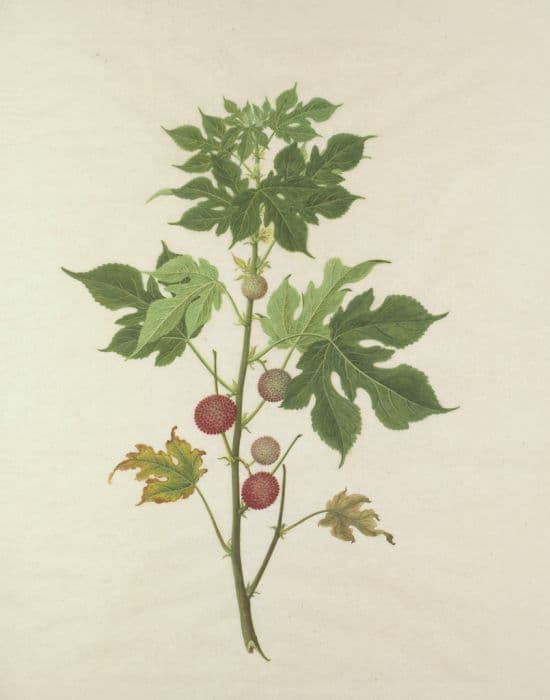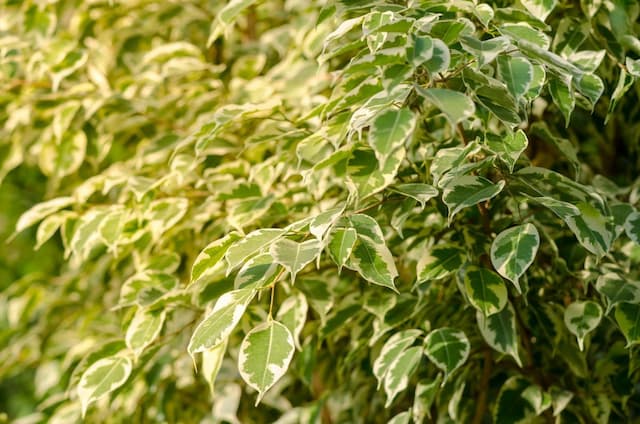Weeping Fig Ficus benjamina 'Citation'

ABOUT
Ficus benjamina 'Citation', commonly known as the Weeping Fig, is a lush ornamental houseplant with striking features. It has a graceful, drooping branch structure that gives it a poised yet relaxed appearance, almost as though the branches are reaching outwards with a gentle arch. The foliage is dense and glossy, with individual leaves exhibiting a rich green color and an elegant, pointed oval shape. Each leaf is thin and delicate, creating a soft texture that is pleasing to the eye. The edges of the leaves are smooth, and they taper to a precise tip. The veining on the leaves is prominent, which accentuates their shape and adds depth to the foliage's appearance. When new leaves emerge, they may display a lighter shade of green, adding a subtle contrast against the mature leaves. Occasionally, the leaves may exhibit slight variegation with patches of lighter green or cream color, though this is less common. The Weeping Fig is adaptable in terms of its branching structure, with some plants growing upright and others adopting a more sprawling form. Its branches are slender and may develop a woody texture as the plant matures. The overall impression of the Weeping Fig 'Citation' is one of elegance and vitality, making it an attractive plant for both home and office environments, where its presence adds a touch of natural sophistication.
About this plant
 Names
NamesFamily
Moraceae
Synonyms
Weeping Fig, Benjamin Fig, Ficus Tree, Benjamin Tree
Common names
Ficus benjamina 'Citation'.
 Toxicity
ToxicityTo humans
The Weeping Fig, or Ficus benjamina, can be toxic to humans if ingested. Its leaves and sap contain compounds that may cause irritation to the mucous membranes. If parts of the plant are consumed, individuals might experience symptoms such as oral irritation, excessive salivation, and nausea. In some cases, it could potentially lead to vomiting or diarrhea. Individuals with sensitive skin may also experience dermatitis upon contact with the sap. It's important to keep this plant out of reach of children, who might be tempted to chew on its leaves.
To pets
The Weeping Fig is toxic to pets, particularly cats and dogs, if they ingest the leaves or come into contact with the plant's sap. Symptoms of poisoning can include oral irritation, drooling, vomiting, and diarrhea. In severe cases, ingestion can lead to difficulty breathing or intense burning and irritation of the mouth, lips, and tongue, potentially causing pets to paw at their faces or exhibit signs of distress. It's advisable for pet owners to keep this plant well out of reach of their animals to prevent any accidental poisoning.
 Characteristics
CharacteristicsLife cycle
Perennials
Foliage type
Evergreen
Color of leaves
Green
Height
6-8 feet (1.8-2.4 meters)
Spread
3-5 feet (0.9-1.5 meters)
Plant type
Tree
Hardiness zones
10
Native area
Asia
Benefits
 General Benefits
General Benefits- Low Maintenance: Ficus benjamina 'Citation', commonly known as Weeping Fig, requires minimal care and is thus suitable for individuals with busy lifestyles.
- Visual Appeal: Its attractive, glossy leaves and graceful drooping branches add aesthetic value to any interior space.
- Longevity: With proper care, Weeping Fig can live for many years, providing long-term greenery in homes or offices.
- Humidity Regulation: It can help in maintaining ambient humidity, which can be especially beneficial in environments with dry indoor air.
- Space Definition: Can be used to create natural partitions in larger rooms, providing structure and organic separation of spaces.
- Noise Reduction: The dense foliage of the Weeping Fig can contribute to noise dampening in echo-prone areas.
 Medical Properties
Medical PropertiesThis plant is not used for medical purposes.
 Air-purifying Qualities
Air-purifying QualitiesThis plant is not specifically known for air purifying qualities.
 Other Uses
Other Uses- Ficus Benjamina is utilized for bonsai creation due to its ability to be trained into miniature tree forms, adding an aesthetic appeal to indoor gardening.
- The flexible branches of Ficus Benjamina can be shaped into living privacy screens or hedges when planted outdoors in suitable climates.
- Dense foliage of Ficus Benjamina serves as a natural habitat and nesting site for birds when planted in the garden or kept outdoors.
- The plant's wood is occasionally used for making small handicrafts or decorative objects due to its fine grain.
- During thematic celebrations or festivals, Ficus Benjamina branches are used for temporary decorative purposes.
- Some cultures use the sweeping form of the Ficus Benjamina as a natural backdrop for photography sessions and artistic installations.
- Ficus Benjamina can be grown over arbors or trellises to create a shaded area, providing a cool retreat during hot summer days.
- In miniature landscapes or fairy gardens, Ficus Benjamina can be pruned to resemble tiny trees, enhancing the whimsical effect.
- Ficus Benjamina leaves can be used as a natural mulch for garden beds, decomposing to add nutrients back into the soil.
- Its sturdy trunks are sometimes used in larger aquariums and terrariums to provide structure and landscape features for fish and reptiles.
Interesting Facts
 Feng Shui
Feng ShuiWeeping Fig is known to help clean the air of negative energies and is often used to enhance positive chi and bring balance. It can be placed in the wealth corner (southeast) or in an area that requires calming, like a study or bedroom.
 Zodiac Sign Compitability
Zodiac Sign CompitabilityWeeping Fig is not used in astrology practice.
 Plant Symbolism
Plant Symbolism- Growth and Endurance: Being a hardy plant that can withstand less-than-ideal conditions, the Weeping Fig symbolizes growth and endurance through challenging times.
- Peace and Plenitude: The lush foliage of the Weeping Fig is often associated with a sense of abundance, peace, and the fulfillment of needs.
- Positive Energy: Known for its air-purifying qualities, the Weeping Fig is thought to bring positivity and clean energy to a space.
- Home and Hearth: As a popular indoor plant, the Weeping Fig represents comfort, domesticity, and the nurturing of relationships within the home.
- Persistence: The Weeping Fig's ability to root and re-root makes it a symbol of persistence and adaptability to new environments or situations.
 Water
WaterThe Weeping Fig should be watered thoroughly, allowing the top inch of soil to dry out before watering again. Typically, this means watering once every 7 to 10 days, but this can vary depending on the humidity and temperature of the environment. When watering, use enough water so that it runs through the drainage holes—approximately half a gallon for a medium-sized pot every time you water. Always avoid letting the plant sit in water, as this can lead to root rot.
 Light
LightThe Weeping Fig thrives in bright, indirect sunlight. Place it near a window where it will receive plenty of light but not directly under the harsh rays of the sun, as that can scorch the leaves. An east-facing window is ideal, where it can enjoy the morning light and avoid the more intense afternoon sun.
 Temperature
TemperatureThe Weeping Fig prefers a warm environment with temperatures ranging between 65 to 75 degrees Fahrenheit. It can tolerate a minimum of 50 degrees Fahrenheit and should not be exposed to temperatures below this, as cold drafts and fluctuations can cause leaf drop. The ideal temperature is around 70 degrees Fahrenheit to ensure healthy growth.
 Pruning
PruningRegular pruning of the Weeping Fig is essential to maintain its shape and encourage fuller growth. Prune in the spring before new growth begins, removing any dead or overgrown branches. This can be done every year or as needed to keep the plant tidy. Light pruning throughout the year is also beneficial to remove dead leaves and help the plant direct energy to new growth.
 Cleaning
CleaningAs needed
 Soil
SoilThe best soil mix for a Weeping Fig (Ficus benjamina 'Citation') is well-draining, rich in organic matter, and has a slight acidic to neutral pH of 6.0 to 6.5. A good recipe would be one-part peat, one-part pine bark, and one-part perlite or coarse sand.
 Repotting
RepottingWeeping Fig (Ficus benjamina 'Citation') should be repotted every 2-3 years to ensure fresh soil and room for growth. Younger, actively growing plants may require more frequent repotting.
 Humidity & Misting
Humidity & MistingWeeping Figs (Ficus benjamina 'Citation') thrive in a humidity level of around 40-50%. They benefit from higher humidity but can adapt to average indoor levels.
 Suitable locations
Suitable locationsIndoor
Place Weeping Fig in bright, indirect light and keep soil consistently moist.
Outdoor
Grow in partial sun and protect from harsh conditions.
Hardiness zone
10-12 USDA
 Life cycle
Life cycleFicus benjamina, commonly known as weeping fig, starts its life cycle with seed germination, which occurs in warm and moist conditions. After germination, the seedling stage begins, characterized by the emergence of the first leaves and root system development, typically taking advantage of a host tree or structure for support. As it matures into a juvenile plant, the weeping fig starts developing a more robust stem and larger leaves, exhibiting its characteristic drooping branches. During its adult phase, the plant reaches reproductive maturity and produces small flowers within structures called syconia, which are pollinated by specialized fig wasps. After pollination, fruits develop within the syconia, containing the seeds that will disperse to begin new plants. The weeping fig has a long lifespan and can remain in its mature, reproductive stage for many years, continuing the cycle with the production of new seeds and fruits annually or biannually.
 Propogation
PropogationPropogation time
Spring-Early Summer
Propogation: The Ficus benjamina, also known as the Weeping Fig, is most popularly propagated using stem cuttings. The best time to do this is during the spring or early summer, when the plant is actively growing. A healthy stem cut from the parent plant should be about 4 to 6 inches (10 to 15 cm) long and include at least a couple of leaves. After cutting, the bottom leaves are removed, and the cut end is dipped in a rooting hormone to encourage root development. The cutting is then planted in a pot filled with a well-draining potting mix and kept in indirect light. Maintaining consistent moisture without overwatering is critical. Roots typically develop within a few weeks, after which the new plant can continue to grow and will eventually require transfer to a larger pot.

